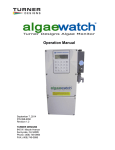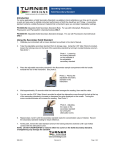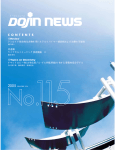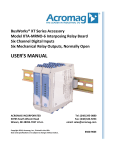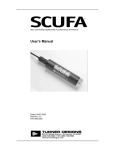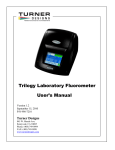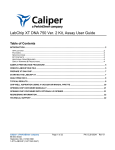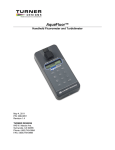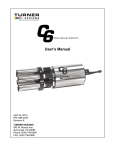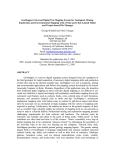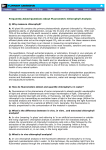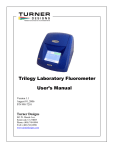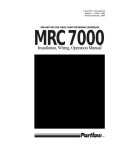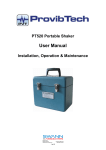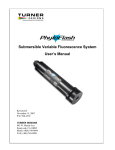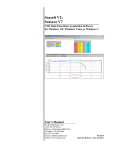Download CyanoWatch operation manual
Transcript
Operation Manual November 4, 2014 P/N 998-6060 Revision 1.3 TURNER DESIGNS 845 W. Maude Avenue Sunnyvale, CA 94085 Phone: (408) 749-0994 FAX: (408) 749-0998 To ensure proper system operation, Turner Designs strongly recommends reading this manual in full. After reading the entire manual, please review the following: INSTALLATION: START-UP: CALIBRATION: TROUBLESHOOTING: Prior to installation, completely review the Pre-installation/ Installation Checklist located in Appendix B. CAUTION: The CyanoWatch should only be used with PVC plumbing kit P/N 6500-955 as supplied Prior to start-up, completely review the Start-Up Section located on page 5. Prior to calibrating the Cyanowatch, completely review the Calibration Procedure located on page 10. Prior to calling Turner Designs for assistance, completely review the Troubleshooting Guide located on page 22. TABLE OF CONTENTS INTRODUCTION .................................... 1 THEORY OF OPERATION ..................... 1 Data Interpretation....................... 2 SPECIFICATIONS .................................. 3 INSTALLATION...................................... 3 Pre-Installation/Installation........... 3 Power & Utilities Required ........... 3 Required Tools & Accessories..... 3 Location & Sampling Point........... 3 Mechanical Connections ............. 4 Electrical Connections ................. 4 START-UP.............................................. 5 Start-Up Procedure...................... 5 Monitoring Mode.......................... 6 CALIBRATION ..................................... 10 Calibration Procedure................ 10 Notes on Calibrating .................. 11 Calibration Data Screen ............ 12 Table 1. Calibration Data........... 12 INTERNAL DATA LOGGER................. 13 Parameters................................ 13 Software Installation .................. 13 Running IDL Software ............... 14 Examining Downloaded Data .... 15 PREVENTIVE MAINTENANCE ............ 16 Cleaning Basket Strainer ........... 16 Calibrating ................................. 16 Cleaning Flowcell ...................... 17 Biofouling .................................. 17 Replacement Parts.................... 17 ALARMS .............................................. 18 Alarm Delay............................... 18 Alarm Activation ........................ 18 Multiple Alarms.......................... 18 Alarm History ............................ 18 Notes About Alarms .................. 18 Definitions ................................. 19 TROUBLESHOOTING ......................... 20 Diagnostics ............................... 20 Troubleshooting Guide .............. 22 Service Assistance/ Returned Goods........................ 24 Specifications/Accessories ................... 25 WARRANTY......................................... 26 APPENDICIES A: CONFIGURATION SHEET............... 27 B. INSTALLATION CHECKLIST ........... 28 C: FIRMWARE FUNCTIONS ................ 29 D: SCREENS FLOW CHARTS ............. 31 System Value Screens User ID Screens........................ 31 Diagnostic Screens ................... 31 Time/Date/Alarm Screens ......... 32 Data Logger Screens ................ 32 Calibration Screens................... 33 E: TROUBLESHOOTING WORKSHEET ... 34 F: FIGURES……………………………….35 G: Cyanowatch White Paper………… …42 FIGURES & DIAGRAMS.......................... Figure 1. Fluorescence Detection ... 1 Figure 2. Front View-External............ 9 Figure 3. Inlet Plumbing .................. 36 Figure 4. Outlet Plumbing ............... 37 Figure 5. Front View-Internal........... 38 Figure 6. Front View-External.......... 39 Definitions ....................................... 41 INTRODUCTION CYANOBACTERIA FLUORESCENCE Cyanowatch is a fluorescence sensor designed to monitor the level of cyanobacteria in water. The Cyanowatch continually senses the concentration of either phycocyanin, (PC) or phycoerythrin, (PE) fluorescent pigments unique to cyanobacteria Phycobilin pigments are a group of accessory pigments unique to cyanobacteria. PC and PE are two phycobilin pigments that also happen to have strong and unique fluorescent signals that can be detected by the CyanoWatch. Cyanobacterial species living in freshwater environments tend to contain predominantly phycocyanin, while marine species contain predominantly more phycoerythrin. Prior to ordering a CyanoWatch, the decision must be made as to which of the phycobilin pigments the instrument will be used to detect. The fluorescence is measured directly, using in vivo cyanobacteria detection, without extraction or chemical treatment. For many types of qualitative work, in vivo measurement alone may answer the experimenter’s questions. For quantitative determinations, the in vivo data is calibrated by correlation with other measurements, such as cell counts, extracted pigment analysis or filter runtimes. the water fluoresces, and a photodiode reads the fluoresced light. The quantity of light emitted is proportional to the amount of cyanobacteria present in the system (see Figure 1 below). The Cyanowatch consists of a microprocessor-based fluorometer with electrical inputs/outputs for a flow switch, 4-20mA signal and data logging. It is engineered to ensure reliability and preassembled to simplify installation. Plumbing and calibration accessories may need to be acquired (see Replacement Parts, page 17, for a list of recommended parts and Figures 3 and 4, pages 36 and 37, for the plumbing diagrams). UNITS Because in vivo cyanobacteria detection is a relative measurement we have not included units on the Cyanowatch screen or in the logged data. However, if correlation between the Cyanowatch signal and cell counts or extracted pigment analysis is conducted, the Cyanowatch can be calibrated to estimate actual cyanobacteria concentration in cells/mL or µg/L, please see Appendix G for greater detail. . THEORY OF OPERATION 90.0 ° Excitation By A Light Source Emission Read By Photodiode Water Sample Flow Figure 1. Fluorescent Detection Theory of Operation Fluorescence data can be used to supply FLUOROMETER an indication of cyanobacteria growth in The sample water containing the sample water. Although the cyanobacteria cells is measured in a sidefluorescence data is not quantitative, see stream of the water as it passes through a Appendix G, a robust relationship between polished, glass tube in the detection the fluorescence signal and actual system. An excitation light source shines cyanobacteria concentration can be easily across the glass tube, the cyanobacteria in determined through a comparison with cell 1 cyanowatch REV 1.3 counts or extracted pigment samples. However, in many instances it may be more useful to develop a relationship between the fluorescence signal and another measure of cyanobacteria growth such as taste and odor analysis, or presence of toxic compounds. In other cases the relative fluorescence signal may be all that is needed to make informed decisions. The power of the Cyanowatch System is in the sensitivity of the fluorescence measurement, and it’s ability to continuously monitor the cyanobacteria community which is constantly changing; sometimes very rapidly. The Cyanowatch is designed to be easily interfaced into external logging or data collection software packages. It has an analog 4-20mA signal that can deliver realtime fluorescence data to an external logging system. The system also has a 20,000-point internal data logger with userselectable data logging intervals. Logged data can be downloaded to a PC using the RS-232 data output port (see Internal Data Logger section, pg. 13). Data Interpretation Upon installation of the Cyanowatch, the fluorescence data should be compared to data from other systems that are affected or used to monitor cyanobacteria. For example, taste and odor problems may be correlated with increased levels of cyanobacteria. Once this relationship has been determined you can set alarms on the Cyanowatch (see Alarms, pg. 18) or through the external logging system to notify you when this level is reached. With this information you will be able to take actions to avoid taste and odor problems. Other examples of data that can be used to compare against the Cyanowatch data include; cell counts, turbidity or extracted chlorophyll data. Once relationships between cyanobacteria fluorescence and other measures of interest have been established, the fluorescence data can be used to assist in decision making. Examples of how the fluorescence data can be used include: 1) Determining when to treat water for high concentrations of cyanobacteria and thus minimizing the amount of treatment chemical used and avoid taste and odor problems. 2) Location of water intake to minimize treating water with high cyanobacterial biomass. 2 cyanowatch REV 1.3 SPECIFICATIONS Sensitivity: 150 cells/mL Linear Range: 0 – 50,000 cells/mL Light Source: Phycocyanin = Yellow: Phycoerythrin = Green Excitation Optics: ;PC = 638 nm; PE = 528 nm Emission Optics: PC = 740 nm; PE = 573 nm Power: 90-250 VAC, 50/60 Hz, 5 amps Relay: 90-250VAC, 50/60Hz, 5 amps (fused at 3.15 amps, Type “F”) Signal Output: One 4-20 mA (isolated) Dimensions: 8” W x 4” D x 15” H Weight: 5 lbs. [2.3 kg] Enclosure: Approximates NEMA 4X Maximum Water Pressure: 100 psi Inlet/Outlet Pipe Size: ¼” NPT (male/female) Outlet Pipe Size: ¼” NPT (female) Ambient Temperature: 40-120 °F [4-49 °C] Maximum Sample Temperature: 140 °F [60 °C] Relative Humidity: 0-100% Overvoltage Category II Pollution Category I The Cyanowatch should be piped as INSTALLATION Pre-Installation/Installation A pre-installation/installation checklist provides important guidelines and information to aid in preparing for installation. The checklist is found in Appendix B. Power & Utilities Required Power: 100-130 VAC/200-250VAC, 50/60 Hz, 5 amps. Signal Output: One 4-20 mA signal (isolated) Water Sample: Supplied to unit at 0.5 gpm minimum and less than 100 psi. Drain: The Cyanowatch sample outlet should be piped to drain with no back pressure, i.e., drain pipes must be below the unit. In installations where this is not feasible, contact Turner Designs Technical Support for further assistance. Required Tools and Accessories Standard plumbing and electrical tools are required for the installation. A terminal strip screwdriver is provided for making terminal strip connections. CAUTION: The CyanoWatch should only be used with PVC plumbing kit P/N 6500-955 as supplied. 3 shown in Figures 3 and 4, pages 36 and 37. The components may be purchased separately or as a package through Turner Designs. Location of Cyanowatch and Sampling Point The Cyanowatch is rated for light industrial environments. Do not install within 10 feet/3 meters of devices such as large generators that generate a strong electromagnetic field. It is extremely important to eliminate air entrapment in the sample line. The best way to accomplish this is to sample from the center of the pipe or from the side of the pipe. The unit should not be installed in direct sunlight; this could cause the internal temperature of the unit to be significantly higher than ambient and produce errors or damage the components. Note: The maximum environment temperature is specified at 120oF/49oC. Do not mount this instrument on cyanowatch vibrating walls or surfaces. Damage can occur to critical components. REV 1.3 Mechanical Connections Refer to Figure 6, Appendix F for the location of the required mechanical connections. Two ¼ inch NPT pipe connections are provided for ¼ inch PVC pipe hook-up. The sample outlet line is ¼ inch female; the sample inlet line is ¼ inch male shut off valve. If the Plumbing Accessory Kit is purchased, the outlet line is ¼ inch NPT (female) to connect to user-supplied ¼ inch male piping; the inlet line is ½ inch NPT (female) to connect to user-supplied ½ inch male piping (see Figures 3 and 4 on pages 36-37). IMPORTANT: Sample discharge should flow to an unrestricted drain. Pipe rises greater than 10 feet [3 m] should be avoided. Mounting eyelets are an integral part of the plastic housing. Mounting the unit at eye level is recommended. To connect a wire to the terminal strip, TURN OFF MAIN POWER TO THE INSTRUMENT AT CIRCUIT BREAKER. Loosen the proper terminal screw (screwdriver provided) and insert wire from below into terminal. Tighten screw firmly. A termination legend is provided on the backside of the enclosure door for reference. To disconnect a wire, TURN OFF MAIN POWER TO THE INSTRUMENT AT CIRCUIT BREAKER. Loosen the termination screw and pull the wire out of the terminal. When finished, carefully insert the ribbon cable onto the PCB and replace enclosure face with the 4 screws. Signal wires and power wiring should NOT be run in the same conduit. Failure to separate or shield these wires will result in electrical interference. Electrical Connections Electrical connections should be made only by trained personnel Refer to Figure 5, pg. 38 for the “Terminal Connections”, showing the terminal strip location and configuration of the required electrical connections for the power, pump, flow switch and 4-20 mA connections. To access the terminal strip, TURN OFF MAIN POWER TO THE INSTRUMENT AT CIRCUIT BREAKER, then remove the lower enclosure face (4 screws). There are two terminal strips within the instrument. #1-9 are for AC connections and A-L are for input/output connections. 4 cyanowatch REV 1.3 START-UP Before start-up, the following items should be procured: Calibration Solution P/N 6500-900 (ordered/shipped separately from unit) Distilled Water Dilute Acid (not included) Plumbing Kit P/N 6500-955 (ordered/shipped separately from unit) Items listed above as ‘ordered/sent separately’ do not automatically ship with an order. For future reference, a diagram of the screens is located on page 31. <0> Cal Soln Value (Calibration Solution Value) -- This value relates the value of the calibration standard to a fluorescence measurement. The default value of 15 from Table 1 on page 12 is recommended, unless you are establishing a correlation to a known concentration as described in Appendix G. Before entering/changing the first System Value, the unit will prompt for the User I.D. and the screen will read Please input ID: Start-Up Procedure 1. Bring the sample flow to the unit. Check for leaks in the plumbing. 2. Switch the Main Power Switch (under the enclosure face; see Figure 2, page 9) to the ON position. The LCD will illuminate. Enter a valid USER ID (default is 8520) Press <ENT> Key in the Calibration Solution Value When the power is first turned on, an ID screen will appear for a few seconds, showing the firmware version and date. After 10 seconds (or press <ENT> or <HOME> for immediate access), the HOME screen will appear. The HOME screen will display the uncalibrated phycocyanin or phycoerythrin fluorescence value (3 digits). If the screen is blank, try adjusting the screen contrast using the UP and DOWN ARROWS. SAMPLE HOME SCREEN Cyanowatch During start-up, all system values should be recorded in the configuration record located in Appendix A. Entering System Values & Definitions From the HOME screen, press <0> to enter/change the first System Value; Calibration Solution Value. 5 Press <ENT> Press <HOME> From the HOME screen, press <1> to enter/change the second System Value; Background Value. <1> Background Value— This value is the background fluorescence (%) for the sample. Background fluorescence can be caused by materials in the sample water that have a similar fluorescence signature to phycocyanin or phycoerythrin. Examples of interfering compounds include dissolved organic matter, accessory algal pigments, and degraded chlorophyll (pheophytin). High concentrations of interfering compounds can result in a slight increase to the fluorescence signal. A means of compensating for this background fluorescence is to estimate the contribution of the interfering compounds to the fluorescent signal and enter the level of interference as the background value. The system will then automatically subtract the entered background level % from the fluorescent reading. The degree of cyanowatch REV 1.3 background fluorescence varies from site to site. The Unit must be calibrated prior to setting the Background Value. To determine the appropriate background value %, filter a sample of water through a GF/F or membrane filter to remove all cyanobacterial cells. Next, inject the filtrate into the Cyanowatch using the syringe provided. Assuming that the default calibration is active (secondary standard set to 500), take the fluorescence value of the filtrate and plug into the following formula; Filtrate fluorescence (X) / 5 = Background Fluorescence % Press <1> Press <ENT> Key in the Background Value (%) Press <ENT> Press <HOME> From the HOME screen, press <2> to enter/change the third System Value; High Signal Alarm Level. <2> High Signal Alarm Level— If the fluorescence level rises above this level (and remains there for a 5 minute delay period), a high signal alarm will be triggered. The alarm triggers the 5V DC signal output which can be used to control external devices such as a light, siren or external control device. Please also see the section on Alarms, page 18. Press <2> Press <ENT> Key in the High Signal Alarm Level Press <ENT> Press <HOME> Initially you will most likely want to leave the High Signal Alarm disabled until you become familiar with the typical fluctuations in cyanobacteria levels. Once this is established you will now recognize abnormally high signal levels and then be able to set the alarm appropriately. 6 From the HOME screen, press <3> to enter/change the fourth System Value; 4 mA Output. <3> 4 mA Output—The 4-20 mA output can be connected by a signal wire to a data logger or other device to collect and store remotely from the unit. Outputs can be set to correspond to a certain range of fluorescence values. Typically the 4 mA output is set at 0. The unit will reject as INVALID INPUT the new 4 mA value if it is not lower than the 20 mA output value. Press <3> Press <ENT> Key in the 4 mA output Press <ENT> Press <HOME> From the HOME screen, press <4> to enter/change the fifth System Value; 20 mA Output. <4> 20 mA Output—The 4-20 mA output can be connected by a signal wire to a data logger or other device to collect and store remotely from the unit. Outputs can be set to correspond to a certain range of fluorescence values. The 20 mA output should be set to a value slightly higher than the highest fluorescence signal (phycocyanin or phycoerythrin concentration) you expect to experience. If the signal exceeds the assigned 20 mA value, the unit will simply output 20mA. If the 20mA value is set excessively high you will limit the resolution of your analog data. The unit will reject as INVALID INPUT the new 20 mA value if it is not higher than the 4 mA output value. Press <4> Press <ENT> Key in the 20 mA output Press <ENT> Press <HOME> cyanowatch REV 1.3 The narrower the range of the 4-20 mA settings, the greater the resolution. During an alarm condition, the 4-20 mA output will still send out the fluorescence signal. During calibration the 4-20 mA output will send out a 4-mA signal. From the HOME screen, press <5> to enter/change the sixth System Value; User ID <5> User ID Change—For security, a USER ID is required to change the System Values or calibrate the unit. The original, or default, value is 8520. To change the USER ID; Press <5> Key in Master ID (1962) Press <ENT> Key in new User ID. Press <ENT> Press <HOME> From the HOME screen, press <6> to view the seventh System Value; AC Relay Status <6> AC Relay Status—Displays the current activation status of AC Relays A and B. This screen is for visual status only. The AC Relays are used to control an external device activation state cannot be altered from the screen. Press <6> Status of AC Relays A & B Press <HOME> Setting the Real-Time Clock For future reference, record all set-up values in Appendix A. Before changing the date or time, be sure to download any data from the data logger. 7 From the HOME screen, press <> to access the date, time, and AC relay alarm values. <0> Hour—For the datalogger to reference the correct time, the hour of day must be entered. Only 1-12 numerical values will be accepted. Press <>, from HOME Press <0> Key in the hour of day (1-12) Press <ENT> Press <ESC> to return to clock menu <1> AM/PM—For the datalogger to reference the correct time (morning or evening), AM/PM must be entered. Use <ENT> to toggle between AM/PM. Press <>, from HOME Press <1> Press <ENT> to toggle between AM/PM Press <ESC> to return to clock menu <2> Minutes—For the datalogger to reference the correct time, the number of minutes after the hour must be entered. Press <>, from HOME Press <2> Key in the minutes after the hour (0-59) Press <ENT> Press <ESC> to return to clock menu <3> Month—For the datalogger to reference the correct date, the month of the year must be entered. Press <>, from HOME Press <3> Key in the month (1-12) Press <ENT> Press <ESC> to return to clock menu <4> Date—For the datalogger to reference the correct date, the day of the month must be entered. Press <>, from HOME Press <4> Key in the day (1-31) Press <ENT> Press <ESC> to return to clock menu cyanowatch REV 1.3 <5> Year—For the datalogger to reference the correct date, the year must be entered. Press <>, from HOME Press <5> Key in the year (00-99) Press <ENT> Press <ESC> to return to clock menu <6> AC Cycle Time— Controls the frequency in which AC Relay Outputs are activated. Range from 10 minutes to 96 hours. Press <>, from HOME Press <6> Press <ENT> to toggle (0min – 96hrs) Press <ESC> to return to clock menu <7> AC On Time— Controls the length of time the AC Relay Outputs stay on when they are activated. Range from 0-100% of the AC Cycle Time. Press <>, from HOME Press <7> Press <ENT> to toggle (0-100%) 8 Press <ESC> to return to clock menu For Example: If you would like to use the AC Relay to control sample source using an automated valve you may want to sample raw water (containing algal cells) for 30 minutes every hour. In this case you would set the AC Cycle Time to 60minutes and the AC On Time to 50%. The result would be that the valve would allow treated municipal water to run through the system for 30 minutes every hour, thus limiting the effects of biofouling, and raw sample water would flow through the system for 30 minutes an hour. The Cyanowatch unit start-up has now been completed. CAUTION: After start-up, wait a minimum of 15 minutes before calibrating the unit to allow the unit to come to equilibrium. cyanowatch REV 1.3 Figure 2. Cyanowatch - Front View-External 9 cyanowatch REV 1.3 CALIBRATION Calibration Procedure The Calibration Procedure will take approximately 5 minutes. The cleaning procedure will take approximately 10 minutes. Refer to Figure 2 on previous page, for locations of items referred to in this procedure. For further reference, a diagram of the screens and a brief summary of the System Values can be found on page 27. Step 1 Step 2 Bubbles trapped in the syringe during injection of the blank or calibration standard are a possible cause of instrument error. With the syringe in a vertical position, tap the syringe against a solid object to move the bubbles to the needle end of the syringe. Then, force the bubbles out by pushing a small amount of solution through the needle end of the syringe. Close the two-way valve flowcell shut-off valve. The valve is closed when the handle is horizontal. Blank and Dilute Acid Solutions: Both the Blank and Acid Solutions are not included with the Cyanowatch System. Deinoized water should be used as the Blank. 10% Sulfuric Acid recommended or 1:1 HCl is acceptable if the flowcell is well rinsed. Calibration Solution: Confirm that the correct Calibration Solution is entered before beginning the Calibration Procedure by pressing <0> from the HOME screen. See Start Up Procedure for details, pg. 5. rate into the flowcell, and allow it to stand for 3 to 5 minutes. Next, using a clean 60 ml syringe, flush the flowcell thoroughly with 60 ml of blank solution. Syringes are provided in the Accessory and Calibration Kits. To purchase additional syringes see Replacement Parts, page 17. Step 3 Press <ENT> from the HOME screen: 1. Calib Cal 0 Days Ago Step 4 Press <1> the unit will request ID entry (unless recently entered): Please input ID: If requested, enter valid USER ID (originally 8520) on the keypad. Step 5 Press <ENT>: CALIBRATE SYSTEM <1> to start Step 6 Press <1>: BLANK SOLUTION Using the blank solution syringe, flush the flowcell with 60 ml of blank solution via the Luer-lock Injection Port. Then inject another 60 ml blank solution and allow it to remain in the flowcell by leaving the syringe attached. Step 7 Clean the unit by injecting the dilute acid solution with a syringe into the flowcell. See Notes on Calibration for details, page 12. The syringe screws onto the Luer Lock fitting on the inlet of the flowcell (see Figure 2, page 9). After filling the syringe with 60 ml of dilute acid, screw the syringe onto the fitting, inject the dilute acid at a slow, steady 10 2. Data cyanowatch Press <ENT>: BLANK %: XXXX REV 1.3 Any value less than 25% is acceptable. If the blank is over 25% and <0> is pressed, you will receive an error message. Press <ESC> to abort the calibration and check the blank solution. When reading is stable, press <0>. The unit will display a flashing “WAIT/wait” message in the lower right-hand corner of the screen while the unit registers the blank. To continue Press <ENT> Step 10 Remove the syringe and press <ENT>: Press <1> to End Calibration Press <1> to accept the calibration settings. The calibration is now complete. YOU MUST press <1> or the calibration will revert to the previous settings. Then, the screen will display: Step 11 Open the flowcell shut-off valve. The valve is open when the handle is vertical. To continue Press <ENT> ** Calibration is finished ** Press <ENT>: CALIBRATION SOLUTION Step 12 Press <HOME> to return to the HOME Screen and normal operations. Using a clean syringe, flush the flowcell with 60 ml of Turner Designs calibration solution (see Replacement Parts, pg.17) via the Luer-lock Injection Port. Then inject another 60 ml calibration solution and allow it to remain in the flowcell by leaving the syringe attached. Step 9 For Phycocyanin instruments, dilute the Turner Designs Calibration Solution to 100 ppb concentration, (4:1 dilution). For Phycoerythrin instruments, dilute Turner Designs Cal Solution to a concentration of 10 ppb (40:1). Press <ENT>: 2. The AC Relay activation schedule is not altered during calibration. 3. A request to begin calibration when an alarm is activated will be denied, unless the alarm is for: High Signal Alarm (“S-H”); CAL SOLUTION %: XX 4. The following alarms will not be monitored during calibration: Wait for the reading to stabilize. The CAL SOLUTION % should be 1-10% When the CAL SOLUTION % is stable and between 1 and 10, press <*>. The unit will display a “WAIT/wait” message in the lower right-hand corner of the screen while it registers the calibration solution. Then, the screen will display: 11 Notes on Calibrating 1. Calibrate the unit when you have time to go through all the steps without interruption (approximately 10 minutes). If the keypad is not used for 15 minutes, the unit will automatically return to the HOME screen. The previous calibration will be maintained. High Signal Alarm (“S-H”); No Sample Flow Alarm (“N-F”) 5. If an internal unit function alarm (“F-A” alarm) occurs during calibration, when you return to the HOME screen, “ALM” will be blinking in the upper left hand corner of the screen. Correct the cyanowatch REV 1.3 14. DO NOT allow the calibration solution to sit in the flowcell for longer than necessary (approximately 2 minutes). condition causing the alarm, then recalibrate the unit. 6. During calibration, the 4-20 mA output will send out a 4-mA signal. 7. Use distilled or de-ionized water as blank solution. If you are not using commercial distilled water, check your source of blank solution against distilled water for background fluorescence. DO NOT USE SAMPLE WATER AS A SOURCE OF BLANK SOLUTION. Use of the wrong blanking solution can result in inaccurate fluorescence values. 15. To abort the calibration and maintain the current calibration settings, press <ESC> before step 9 is completed. The unit will prompt <1> Abort Cal <ESC> Continue Press <1> to abort. 8. Use only Turner Designs fluorescence calibration solution (see Calibration Solutions in the Replacement Parts, page 17). These calibration solutions meet strict specifications that are difficult to achieve when the solutions are made at the customer’s site. Not using the Turner Designs solutions could result in inaccurate fluorescence values. 16. 9. All solutions are injected with a syringe into the stainless steel Luer-lock Injection Port. Depress plunger at a steady, slow rate. Table 1. Calibration Data Blank Calibration Data Screen This screen provides a check on proper calibration. It is accessed from the HOME screen by pressing <ENT>, then <2>. Access Key Default Range 10. Use a separate syringe for the blank and calibration solutions. 11. Avoid injecting bubbles into the unit. Bubbles trapped when injecting the blank and calibration solution are a possible cause of instrument error. With the syringe in a vertical position, tap the syringe against a solid object to move the bubbles to the needle end of the syringe. Then, force the bubbles out by pushing a small amount of solution through the needle end of the syringe. The entire calibration procedure must be completed for the new values entered during calibration to be store Cal Std <ENT> & <2> 0.0 15.0 0-250 0-1,000 Blank: Shows raw data output for blank solution as set during calibration. It can be used to check proper calibration. Blanking capability of the instrument is 25% (e.g. maximum blanking of raw data is 250.0) Cal Std: Shows raw data output for the standard solution as set during calibration. It can be used to check proper calibration. 12. The LEFT ARROW may be used to return to previous calibration screens. 13. During the calibration sequence, MAKE SURE to wait for BLANK % and CAL SOLUTION % readings to stabilize before pressing the appropriate key on the keypad. 12 cyanowatch REV 1.3 INTERNAL DATA LOGGER Cyanowatch is equipped with an internal data logger to record the unit’s output. Data is saved in a compressed binary (BIN) format to be downloaded and converted to ASCII data with the Internal Data Logger (IDL) software. Data Logger Parameters The unit’s data logger is accessed from the HOME screen by pressing the data disk <> symbol on the keypad. From the data logger menu, you can turn the data logger on/off, set the interval, and download and erase data. 1. The clock is important to the data logging functions. Once the date and time are set and data has been logged, download the current data before changing the date or time or you may corrupt or erase your data. From the HOME screen, press <> to see the data logger menu. Before entering/changing the data logger, the unit will prompt for the User I.D. (Default=8520) and the screen will read: Download current data before changing the data-logging interval or you may corrupt your data. 4. To download the data to a Windows based PC or to erase data, from the data logger menu, press <2> or <3>, respectively. Installing the Internal Data Logger Software The Internal Data Logger (IDL) software is designed to interface from the Cyanowatch to a Windows based PC. The IDL program is used to download the compressed data from the Cyanowatch and convert it to an ASCII format for use with a spreadsheet or other program. To install the IDL software: 1. Insert the IDL disk into your computer. 2. Access “Run” from Windows. Type: a:\setup. (Be sure to enter the correct drive for the disk. Running the Internal Data Logger Software Please input ID: After entering the User ID the screen will read: Datalogger: <0> - <3> 2. To log data or stop logging data, press <0>: Status: Stop <ENT> to toggle Press <ENT> to toggle from Stop to Logging. Press <ESC> to return to the main Datalogger screen. 3. To set the data logging interval press <1>. Press <ENT> to toggle from 1, 2, 3, 5, 10, 20, or 30 minutes, or 1 second. To download data from the Cyanowatch: 1. Using the cable provided, connect your computer to the unit’s serial port phone jack style connector. See Figure 2, page 9 to locate. 2. Load the IDL program on the PC by clicking twice on the IDL.exe icon. The IDL Main Menu will appear. 3. Click on Serial Port Setup to select the appropriate port (1, 2, or 3) for your PC. 4. Click on Download Data from Instrument to File to display the downloading box on the PC. Interval: 1 min <ENT> to toggle 13 cyanowatch REV 1.3 You may download and convert to an ASCII file in a single process by clicking on Download and Convert Data from Instrument to File. In this case, IDL will prompt you for downloading, then conversion in a single process incorporating steps 5 - 10. 8. If you would like to wait until later to convert the data to ASCII format in order to save disk space, then skip to step 12. To convert the data to an ASCII file now, go on to step 9. 5. From the Cyanowatch, set the data logger to Stop, by pressing <> from the HOME screen, then <0>, then <ENT> to toggle. 6. From the Cyanowatch, access the downloading screen by pressing <2> from the data logger main menu: Download data: 5x <8> to start 7. On the Cyanowatch, press <8> five times to start downloading data. The PC will display a bar graph and data block countdown. The Cyanowatch will display: Download data: Data Blks: XX If there is an error in downloading data, the following screen will be displayed: Comm error !!! <ESC> to retry a. If the error screen appears, press <ESC> and make sure the serial cable is securely connected and operational. b. Make sure the correct serial port has been selected (IDL software main menu). c. Check to make sure that the Cyanowatch date and time functions have not been changed for the current data logged. 9. To convert a BIN file to a regular ASCII file (PRN file), from the PC click on the Convert Downloaded Data File to ASCII File. IDL will then ask you what file you would like to convert to ASCII. Click on Browse to locate the file or click on OK to accept the default file. 10. Click on OK to begin conversion. IDL will display “Conversion has started.” IDL will convert the BIN file to an ASCII file of the same name with the extension “PRN”. When “Conversion completed” appears, click on OK to return to IDL Main Menu. 11. To exit IDL, click on the “X” in the upper right-hand corner of the software window or select “Exit” from the file menu. 12. Disconnect the computer from the unit. Erase the data currently in the Cyanowatch by pressing <> from the HOME screen, then <3> from the data logger menu: Erase data: <9> 5X to start When data is erased, the unit will display: d. Verify that you completed steps 1 - 7. Correct screens must be displayed on both the computer and Cyanowatch. 14 When downloading is finished, IDL will ask you to name the file and select the path (folder) for the downloaded file. Click on Browse to change the name or path; or you can accept the default name (test.bin) and path. Then, click on OK to return to the Main Menu. cyanowatch Erase data: All Data Erased REV 1.3 13. Enter new internal data logging parameters on the Cyanowatch if desired, or resume logging with the previous parameters. 14. Return the unit to normal operation. Examining the Downloaded Data The ASCII-format “PRN” files can be opened, viewed, or printed using most standard computer programs. To examine the data, run your program, then open or import the “PRN” file containing the downloaded data. A typical line of data from the internal data logger will look like this (your numbers will vary): 00001: 10/24/91 14:10:28 Index Date Time 15 = 11.300 Sample Reading cyanowatch REV 1.3 PREVENTIVE MAINTENANCE Proper preventive maintenance is critical to the success of the Cyanowatch System. Once the unit is installed, started-up, and calibrated, the initial settings should not require change. Refer to Start-up, page 5, of this manual for instructions. Any startup or shutdown must be made using the Cyanowatch Main Power Switch (see Figure 2, page 9). The System Values are retained in battery back-up memory for up to five years. However, the Start-up procedure should be followed to ensure fluorometer calibration and alarm settings are correct if the unit has been disconnected for any length of time. This unit has been assembled with a new desiccant plug to ensure the area surrounding the flowcell is free of any moisture. As this plug absorbs condensate, it will change from a light blue to light pink at the saturation point and should be replaced promptly. The unit can remain in operation during this replacement. Readings should be monitored during this replacement time as small variances might occur. Refer to the Replacement Parts section, pg. 17, for replacement plugs ordering information. The following preventivemaintenance should be performed to ensure optimum operation and maximum life. Cleaning the Basket Strainer The basket strainer screen should be cleaned as needed as follows: 1) Shut off the inlet valve to the basket strainer; 2) Remove the screen by unscrewing the clear plastic basket housing and clean the screen; 3) Replace the screen; 4) Open the inlet valve to the basket strainer. 5) Wait for the unit to equilibrate and air to purge from the unit. Calibrating Typically, calibration should be checked using the secondary standard included in the calibration kit every two to three weeks. Cleaning the Flowcell How often the flowcell should be cleaned depends on the quality of the water being monitored. The flowcell is unlikely to clog, but occasionally residue or biofilms can build up on the inside of the glass cuvette. A fouled or discolored flowcell can result in low or erratic readings. Initially, routine flowcell cleaning should be conducted and fluorescence readings before and after cleaning should carefully noted. If a significant change in the reading resulted from cleaning, a shorter cleaning interval should be implemented. If there was no significant change in the reading after cleaning, a longer cleaning interval can be used. For routine cleaning, follow steps 1 and 2 in the Calibration Procedure, page 10; open the flowcell shut-off valve when cleaning completed. For cleaning the flowcell with a brush, perform the following steps (refer to Figure 2, pg. 9): 1. Turn OFF the Main Power Switch. 2. Shut off the flow to the flowcell. Flow is off when valve handle below the flowcell is horizontal. It is recommended that the inlet valve be closed and the 3-way outlet valve also be closed (the outlet valve is then open to the atmosphere; see Figures 4 and 5, pages 37-38). 3. CAUTION: After injecting acid solution into the flowcell via the luer lock port, be sure to flush it out completely BEFORE removing the clean-out cap. 4. Remove the clean-out cap and open the clean out valve (horizontal position). Dip the flowcell brush into the dilute acid solution and insert it gently into the cleanout opening. Calibration should be checked regularly. 16 cyanowatch REV 1.3 5. Slide it gently up and down in the opening to remove any coating on the glass cuvette. 6. Close the clean-out valve (vertical position) and replace the flowcell cleanout cap. 7. Turn on the flow. Flow is ON when the valve handle is vertical. 8. Turn ON the Main Power Switch. Replacement Parts: 6500-900 Cyanobacteria Cal Kit 6000-970 Desiccant Plugs (Pkg. 3) 6000-350 Flowcell Brush (Pkg. 3) 6000-119 Data Cable 6000-910 Syringes (Pkg. 10) 120-0110 Flow Switch 119-0103 Basket Strainer 9. Calibrate the unit after allowing it to warm up for 15 minutes (refer to Calibration Procedure, page 10). Biofouling Sample water containing bacterial and algal cells will be in contact with the glass flowcell of the Cyanowatch System. Because of this a biofilm will gradually begin to grow on the flowcell and at some point the film will become thick enough to interfere with the fluorescent readings. The rate of fouling will change from site to site. The Cyanowatch has an optical compensation system that will correct for fouling to a certain point. Beyond this it is the user’s responsibility to clean the flowcell on a regular basis to prevent corruption of the data. There are several ways in which the rate of biofouling can be slowed. 1) Flow rate: As the flow rate in the flowcell increases the rate to which biofouling organisms and attach and grow on the flowcell walls will decrease. The minimum flow rate required is 0.5 gpm. Flow rates in the range of 2-5 gpm could significantly decrease flowcell fouling rates. 2) Flowcell cleaning: The Cyanowatch has been designed to allow quick and easy cleaning of the flowcell. A regular schedule should be established in order to prevent the establishment of biofouling organisms on the flowcell. 17 cyanowatch REV 1.3 ALARMS Alarms have been built into the unit to warn about conditions relating to high algal levels and internal instrument functions. There are two types of alarms for Cyanowatch: 1. System function alarms, Fluorometer (lamp) and No Flow (“F-A” and “N-F” alarms). See Table 2. The alarm history can be viewed, by pressing <> (LEFT ARROW) from the HOME screen. This shows which alarms have been activated since the alarm history screen was last cleared. To clear this screen, press <*> five times while the alarm history screen is displayed; “No alarm since last reset” will be displayed. Notes About Alarms 2. High Signal alarms. See Table 3, page 19. Alarm History 1. Refer to Table 5, page 25, for default values. 2. Alarm Delay To avoid unnecessary triggering of alarms, the condition must be in effect for a certain delay period. See Tables 2 and 3. 3. Alarm Activation When an alarm is triggered, “ALM” will blink in the upper left hand corner of the HOME screen. From any other screen, when the alarm is first activated, the unit will return to the HOME screen, display the “ALM” message in the upper left hand corner. Pressing the <ESC> key will display the current alarm. Take the appropriate action to clear the condition (see Troubleshooting, page 20). When the condition triggering the alarm is cured, “ALM” will disappear from the HOME screen. Alarms cannot be aborted without curing the problem. Multiple Alarms If multiple alarms are triggered, alarms will be listed on the alarm screen when <ESC> is pressed from the HOME screen. Note: Alarms are not listed in the order they occur. For example, the alarm screen might display: N-F 18 4. 5. No alarms are monitored when the unit is turned OFF. Certain alarms are not monitored during calibration (see Notes on Calibrating, page 11). When the unit is first powered up, the HIGH SIGNAL alarm will begin to be monitored 5 minutes after start up. Thus, a problem or spike during startup will not mistrigger the HIGH SIGNAL ALARM. All alarms will be reset automatically if the alarm condition is corrected. During an alarm condition, the 4-20 mA will still send out the fluorescence signal. Table 2. System Function Alarms Alarm Lamp (F-A) No Sample Flow (N-F) Delay (min.) Alarm Condition Normal 1 OFF ON 5 OFF ON Table 3. High Signal Alarms Alarm High Signal (S-H) Delay (min.) 2 Range Default 0.2-999 999 F-A cyanowatch REV 1.3 System Function Alarm Definitions a. Lamp (F-A)--Indicates the status of the excitation light source. Reports whether the lamp is OFF or ON. If the power is ON and the lamp is good, the diagnostic screen will display “Lamp: ON”. b. No Sample Flow (N-F)--If there is a problem with the sample flow lasting for the 10 minute delay period, a “N-F” alarm will be noted. The flow switch used is rated at 0.5 gpm minimum flow (tolerance is 0.4 0.6 gpm). If there is a “N-F” alarm, check terminal connections to the flow switch. Check the sample feed lines and the unit’s flowcell for any restriction. Electrical connections should be performed only by trained personnel. To determine which alarm is currently active, press <ESC> from the HOME screen and the alarm status screen will appear. F-A N-F You may also view the lamp and flow status in real-time by accessing the diagnostic screens. The diagnostic screens are accessed by pressing <*> from the HOME screen and then <ENT>. See Diagnostic Screen flowchart, pg. 31. If the Lamp displays “OFF” and there is power to the unit, contact the Turner Designs Technical Support. High Signal (S-H)--If the fluorescence signal rises above the user-set level (see Table 5, page 24), and remains there for the 2 minute delay period, a “S-H” alarm will be noted. If there is a “S-H” alarm, check if the High Signal Alarm Level is set too low. Verify that calibration has been performed properly. 19 cyanowatch REV 1.3 page 11) to determine whether the last calibration seems correct. TROUBLESHOOTING Introduction Because the Cyanowatch system includes hardware, software, and chemistry, it is important to collect all the diagnostic data first. To facilitate data collection, each Cyanowatch unit is shipped with the Troubleshooting Worksheet ( E). After collecting the data requested by the worksheet most problems can be solved over the phone with the assistance of Turner Designs Technical Services. See Service Assistance/Returned Goods, page 24, for contact information. When using this guide, it is assumed that all problems associated with an alarm have been resolved first. Something as simple as a clogged basket strainer can lead to other alarm messages, which could all be solved at one time simply by cleaning basket strainer. Generally speaking, if there is no System Function Alarm (“F-A” alarm), this is persuasive evidence that the electronics of the instrument are functioning properly. In that case, it is likely that any problem is either mechanical, or has resulted from another system problem, or it or it may be an operational error. The troubleshooting procedure works best in this sequence: 1. Handle any alarms (see Alarms, page 17). 2. Determine whether or not the System Values have been entered correctly (see recorded values in Appendix A and the System Default Values in Table 5, page 24). 3. Perform the Diagnostics procedure as described on the following page. 4. Determine whether or not the chemistry is behaving as expected. Does the blank read close to zero on the HOME screen and calibration solution read between 1-5% on the calibration screen? Check the “Cal data” screen (see Calibration Data Screen, 20 5. Complete the Troubleshooting Worksheet, Appendix E. 6. Contact the Turner Designs Technical Support (see Service Assistance/Returned Goods, page 24). Diagnostics Cyanowatch contains diagnostic screens and functions to aid in troubleshooting. These functions are accessed from the HOME screen by pressing <*>, then <ENT> to page through the series of 4 screens. Press the <LEFT ARROW> to return to a previous screen, or <ESC> or <HOME> to return to the HOME screen. 1. From the HOME screen, press <*> TURNER DESIGNS 6600XBL 1.0 0302 This screen displays the version number and release date of the firmware installed in the instrument. 2. From the above screen, press <ENT> Raw: XXX FS% XX Raw—The “raw” signal output is the output from the unit’s light detector. This is the output Cyanowatch uses (in conjunction with the Cal Soln Value, Background value, etc.) to arrive at the fluorescence readout on the HOME screen. It can be used to diagnose problems with the unit. For example, if the HOME screen always reads zero, and the Raw reading is also zero, there may be an optics problem. If the HOME screen reads zero but the Raw reading does not read zero, then check the Cal Soln Value to make sure the proper value is entered. FS%--Acts like an analog meter. Indicates the raw signal output as a percentage of the maximum that can be read. Value Range RAW 0.00 to 1000.00 (reading >1000.00 will display “OVER”) FS% 0 to 100 (if Blank equals 0) cyanowatch REV 1.3 Cal std: XXX.X 3. From the above screen, press <ENT> 1: Test RlyA: ON 2: Test RlyB: OFF For definitions, ranges, and default values of these items, see Calibration Data Screen, page 12. AC Outputs—Two independent solid state relays control AC electrical output through connections (terminal strip connections 49) If Cyanowatch is connected to an automated valve or other control device via terminal strip connections 4-9, this function allows you to test whether the unit’s internal circuitry is operating and terminal strip connections are correct. To test the device control of the Cyanowatch, the device itself must be on, working, and properly connected to the terminal strip. Press <1> (or <2>) from the screen above, then <ENT> to toggle the chosen relay ON and OFF. The device should go on when ON is selected and off when OFF is selected. If it does not, then be sure to check the device itself first, then check the terminal strip connections (trained personnel ONLY). When the test is finished, return to the HOME screen and device control will revert to control by current unit values. This function can serve as a “manual override” for device control tests. While on this screen, you can turn a device on and off regardless of the unit values previously entered. 4. From the above screen, press <ENT> Oper: XXXX Hrs Lamp ON Flow: ON Oper—This indicates how many hours the unit has been in operation since installation. Lamp—This indicates whether the LED light source is operating properly. Flow—This indicates whether the flow is ON/OFF. 5. From the above screen, press <ENT>: Blank: X.X 21 cyanowatch REV 1.3 Troubleshooting Guide REMEMBER, handle any alarms FIRST. SYMPTOM POSSIBLE CAUSE SOLUTION HOME screen displays over/OVER (blinking from over to OVER). 1. System Values are incorrect (i.e. Cal Soln Value, etc.). 1. Check the Configuration Record for the site. Access the System Values and verify that they are entered correctly. 2. Incorrect calibration 1. Check the Calibration Data screen. Recalibrate the unit; be sure to use the correct calibration solution and that the reading is between 1% - 10%. Check the expiration date of the solution. 1. Possible optics problem. Improper or deteriorated filters. Check the FS% reading in the Diagnostics sequence. A blinking ‘over/OVER’ is a different symptom than a steady ‘OVER’ and indicates that the sample reading exceeds 999. This is most likely related to the System Values entered for the site. If, for example, a Cal Soln Value of 200 was erroneously entered, the unit’s numerical calculation of the sample reading might exceed 999. (NOTE: Examine “Possible Cause”/”Solution” in the numbered order.) HOME screen displays OVER (not blinking from over to OVER). A steady ‘OVER’ is a different symptom than a blinking ‘over/OVER’ and indicates that the sample reading is too high for the unit’s light detector. This is related to the chemistry of the sample and displays that the sample readings are too high for the unit at the current sensitivity level. (NOTE: Examine the “Possible Cause”/”Solution” in the numbered order.) 22 cyanowatch REV 1.3 SYMPTOM POSSIBLE CAUSE 2. Incorrect calibration. 3. System Values are incorrect (i.e. Cal Soln Value, etc.). HOME screen displays minus sign (negative readings), i.e., sample is reading less concentrated than blank as set during last calibration. 1. Fouled flowcell. Thoroughly clean and rinse flowcell with recommended solution, using the brush if necessary. (See Cleaning the Flowcell, page 16.) 2. Calibrated with contaminated blanking solution, or the calibration solution was used instead of the blank solution. Recalibrate. HOME screen reads zero. System Values incorrectly set. Make sure valid System Values entered (see Appendix A). Screen blank or black. LCD’s screen contrast too high or too low Unit does not calibrate. Failure to complete entire calibration procedure. AC Out is not operating properly. 1. Problem with terminal strip connections; or device itself. If screen is blank, adjust contrast by pressing UP ARROW (if screen is black, use the DOWN ARROW) continuously until screen is visible. Use UP and DOWN arrows to fine adjust. You must press <1> at the end of the calibration sequence for the unit to accept the values. Recalibrate. If there is an alarm, check the High Signal Alarm for 0-5V signal problems. Refer to Diagnostics (page 20), AC Out test function, to test if the unit is properly controlling the device using the AC Relays. Make sure the device itself is powered on and operational. Replace fuse with spare fuse located in the spare fuse holder on the PCB. 2. Fuse has ‘blown’. 23 SOLUTION Recalibrate the unit, making sure that you are using the correct Calibration Solution, and that it reads between 1 and 10%. Check the expiration date of the solution. Check the Configuration Record. Access the System Values and verify they are entered correctly. cyanowatch REV 1.3 SYMPTOM POSSIBLE CAUSE SOLUTION Background value ineffective (i.e. HOME screen reading does not change when the Background value is changed). This is not usually cause for alarm as the HOME screen reading is a result of a combination of factors. Do not attempt to change current settings unless you are certain something is wrong. Consult with the Turner Designs Technical Services. Unit does not respond to calibration solutions. System Values incorrectly entered. Check that the correct Background Test Value and Cal Soln Value have been entered (see Appendix A). SERVICE ASSISTANCE/RETURNED GOODS Turner Designs’ experienced technical staff is available to assist you in troubleshooting the Cyanowatch unit. However, should you need to return anything for the unit, a Returned Materials Authorization (RMA) must be obtained from Turner Designs. Please call prior to returning any equipment. The use of an RMA minimizes the potential for administrative delays and facilitates prompt turn-around. Turner Designs Technical Support Telephone: 877-316-8049 (Outside U.S. 408-749-0994) FAX: 408-749-0998 E-mail: [email protected] Hours: 8:30 a.m. – 5:00 p.m., Pacific Time 24 cyanowatch REV 1.3 SPECIFICATIONS AND ACCESSORIES Specifications Sensitivity 150 cells/mL Linear Range 0 – 50,000 cells/mL Light Source Phycocyanin = Yellow: Phycoerythrin = Green Excitation Optics PC = 638 nm; PE = 670 nm Emission Optics PC = 740 nm; PE = 573 nm Power: 90-250 VAC/200-250 VAC, 50/60 Hz, 5 amps Relays: 90-250 VAC/200-250 VAC, 50/60 Hz, 5 amps (fused at 3.15 amps ea. Type “F”) Signal output: One 4-20 mA, isolated Dimensions: Weight: Enclosure: 8” W x 4” D x 15” H; 20cm x 10cm x 38cm 5 lbs; 2.3 kg Approximates NEMA 4X Sample Flow: Maximum Water Pressure: 100 psi Plumbing: Inlet/Outlet Pipe Size: ¼” NPT (Male/Female) Environment: Ambient Temperature: Maximum sample temperature: Relative Humidity: 40°F to 120°F; 4°C to 49°C 140°F; 60°C 0-100% Table 5. System Default Values and Ranges 25 SYSTEM VALUE ACCESS KEY DEFAULT VALUE RANGE Cal Soln Value <0> 15.00 0.000 to 998.000 Background Value <1> 0.0% 0.0 to 100.0 High Signal Alarm Level <2> 999.000 (PPM) 0.004 to 999.000 4 mA Output <3> 0.000 0 to 998.000 20 mA Output <4> 100.00 0.002 to 999.000 Software Version <*> N/A Fixed Master ID <5> 7420 Fixed User ID <5> 8520 0 TO 9999 AC Cycle Time <clock>, <6> OFF 1 to 168 hours AC On Time <clock>, <7> OFF 1 to 1440 min. cyanowatch REV 1.3 Accessories Included with Unit Flowcell brush Terminal strip tool Operating manual 2 spare clean-out port caps Datalogger cable Datalogger disk Spare desiccant plugs USB with operating manual Suggested Optional Accessories Calibration Kit 6500-900: Kit includes Calibration Standard (1L), syringes, flowcell brushes Plumbing Kit P/N 6500-655: includes inlet and outlet plumbing kits Warranty Terms Turner Designs warrants the Cyanowatch and accessories to be free from defects in materials and workmanship under normal use and service for a period of 12 months from the date of shipment from Turner Designs with the following restrictions: • Turner Designs is not responsible for replacing parts damaged by accident or neglect. Your instrument must be installed according to instructions in the User’s Manual. Damage from corrosion is not covered. Damage caused by customer modification of the instrument is not covered. • This warranty covers only Turner Designs products and is not extended to equipment used with our products. We are not responsible for incidental or consequential damages, except in those states where this limitation is not allowed. This warranty gives you specific legal rights and you may have other rights which vary from state to state. • Damage incurred in shipping is not covered. Warranty Service To obtain service during the warranty period, the owner shall take the following steps: 1. Write, email or call the Turner Designs Technical Support department and describe as precisely as possible the nature of the problem. Phone: 1 (877) 316-8049 Email: [email protected] 2. Carry out any adjustments or tests as suggested by the Technical Support Department. 3. If proper performance is not obtained you will be issued a Return Materials Authorization number (RMA) to reference. Package the unit, write the RMA number on the outside of the shipping carton, and ship the instrument, prepaid, to Turner Designs. If the failure is covered under the warranty terms, the instrument will be repaired and returned free of charge, for all customers in the contiguous continental United States. 26 cyanowatch REV 1.3 For customers outside of the contiguous continental United States who purchased equipment from one of our authorized distributors, contact the distributor. If you purchased directly, contact us. We will repair the instrument at no charge. Customer pays for shipping duties and documentation to Turner Designs. Turner Designs pays for return shipment (custom duties, taxes and fees are the responsibility of the customer). Out-of-Warranty Service Follow steps for Warranty Service as listed above. If our Technical Support department can assist you by phone or correspondence, we will be glad to, at no charge. Repair service will be billed on a fixed price basis, plus any applicable duties and/or taxes. Shipment to Turner Designs should be prepaid. Your bill will include return shipment freight charges. Address for Shipment: Turner Designs, Inc. 845 W. Maude Ave. Sunnyvale, CA 94085 27 cyanowatch REV 1.3 APPENDIX A CONFIGURATION RECORD Date Configured: _____ Technician: _____ Serial Number:_______ System Value Range Background Value 0.0 to 100.0 % Cal. Solution Value 0.000 to 998.000 High Signal Alarm Setpoint 0.004 to 999.000 4mA Output 0.000 to 998.000 20mA Output 0.002 to 999.000 AC Cycle Time 10min – 96hours AC On Time 1 to 100% of AC Cycle Time User ID 4 digit 28 cyanowatch Configuration REV 1.3 APPENDIX B Pre-Installation/Installation Checklist The following checklist is provided so the appropriate preparations may be made prior to equipment start-up. Completion of the listed items is mandatory to assure proper installation and a properly-functioning piece of equipment. 1. ________ ________ 2. ________ ________ 3. ________ ________ Check sample water background fluorescence (Background lab test code). Check that the turbidity is less than 150 NTU. Assure water temperatures of 32-140 oF. INSTALLATION REQUIREMENTS - CUSTOMER 1. ________ ________ Locate the unit within 125 feet from the sample point. 2. ________ ________ Locate the unit out of direct sunlight. 3. ________ ________ Locate the unit where ambient temperatures are 40-120 °F/4-49 °C. 4. ________ ________ Locate the unit at least 10 feet/3 meters from devices such as large generators, which require a great deal of electrical power, or generate a strong electromagnetic field. CUSTOMER REQUIREMENTS - PLUMBER 1. ________ ________ The sample stream must be plumbed to the unit to deliver at a rate >0.5 gpm (between 0.5 and 1.25 gpm is optimal) and <100 psi. One ½-inch and one ¼-inch NPT pipe connections (both female) are provided for PVC pipe hook-up. Refer to Figure 3 and 4, page 3637. Ensure that sampling point will avoid air entrapment. 2. ________ ________ Sample from the side of the water line to avoid air entrapment. 3. ________ ________ Provide a free, unrestricted drain for the sample stream, preferably to the tower basin - no back pressure, max. 10 ft/3 m rise. CUSTOMER REQUIREMENTS - ELECTRICIAN 1. ________ ________ Ensure that the environment will support a NEMA 4X-type enclosure. 2. ________ ________ Provide 90-250 VAC, 50/60 Hz, 5 amp electrical service to the Cyanowatch. 3. ________ ________ If the unit’s 4-20 mA output signal will be used, check to see if an isolator should be purchased. 4. ________ ________ Terminate flow switch wiring on terminal strip (refer to Figure 5, pg. 38). FINAL REQUIREMENTS - CUSTOMER 1. ________ ________ Obtain needed materials (calibration solution, distilled water, dilute acid, calibration kit, flowcell cleaning brushes) Customer’s Responsibilities: This checklist outlines the work that is required prior to start-up. Work is necessary to ensure quality and proper operation. However, if any of these requirements cannot be met, contact Turner Designs Technical Services. In some cases, alternative procedures will still provide reliable results. 29 cyanowatch REV 1.3 APPENDIX C FIRMWARE FUNCTIONS The unit has a software interface that simplifies calibration and changes of unit values (See Screens Flow Charts, pages 31-33). The following descriptions of the unit’s software functions will help provide a better understanding of the unit: 1. Screens—Built into the unit are a series of computerized screens, which are called up using the keypad and shown on the digital display. 1.1 Home Screen—Once the unit has been activated, the HOME screen is continuously displayed, except when accessing other screens. From the HOME screen, access the calibration data and the calibration sequence by pressing <ENT>. Other screens are accessed from the HOME screen by pressing various keys on the keypad. Go to the HOME screen by pressing the <HOME> key, except during the calibration procedure. To return to the HOME screen from calibration, first press <ESC> to abort the calibration sequence. 1.2 Warning Screens—There are warning screens throughout the software that inform of invalid entries (for values or ID). 1.3 Alarms—When an alarm occurs, “ALM” blinks in the upper left hand corner of the HOME screen. The nature of the alarm can be discovered by pressing <ESC> from the HOME screen (see Alarms, page 17, and Troubleshooting, page 19). 2. Keypad Functions 2.1 Left Arrow—The LEFT ARROW can be used to correct typing errors when data is being entered or changed. It acts as a backspace or delete key. During calibration, it can be used to return to previous screens in the sequence if you wish to re-run the calibration. It is also used from the HOME screen to view the alarm history. 2.2 Up and Down Arrows—From HOME screen, can be used to change screen contrast. 2.3 Escape and Enter—You can escape to the previous screen or abort the calibration sequence by pressing the <ESC> key. While viewing a System Value, press <ENT> to access the screen to change that value. After entering a new System Value, press <ENT> to accept the new value. 3. User Identification—To change System Values or to calibrate the instrument, a four-digit USER ID is required. For security, a MASTER ID, different from the USER ID, is required to view or change the USER ID. 30 cyanowatch REV 1.3 Once an ID has been entered, if the keypad is not used for 15 minutes, the unit will automatically return to the HOME screen. The ID will have to be entered again before the unit values can be changed or calibration can be performed. 4. Fluorescence Display—After the unit is powered-up or after calibration, the fluorescence displayed will not react immediately, but will respond after a delay of about 10 seconds. 5. LCD Contrast—The contrast of the Liquid Crystal Display can be adjusted on any screen (except during calibration) by pressing the UP and DOWN ARROWS. 31 cyanowatch REV 1.3 APPENDIX D Screens Flow Chart Systems Values. From the HOME screen, press key to view value. To change value, press <ENT> while viewing, input ID, enter new value, and press <ENT> again. Press HOME screen. XXX Cyanowatch HOME Home Screen shows fluorescence signal and whether data logger and alarms are active. Cal Soln value: XXX.XXX Relates the value of the tracer standard to a fluorescence measurement. 1 Background Value XX.X Background fluorescence for system. 2 High Sig Alarm: XXX.XXX Set the fluorescence value that once exceeded will set the High Signal Alarm 4mA output: XXX.XXX Output can be set to correspond to a certain fluorescence signal. 0 3 4 ← ESC 32 20mA output: XXX.XXX S-H N-F N-F View alarms triggered since last reset. To view or change User ID, Master ID is required: Input MASTER ID: 5 ENT XXXX New: Diagnostic Screens. To access unit's diagnostic screens, from HOME press: Θ TURNER DESIGNS 6600XBL 1.0 0302 ENT Raw: XXX.XX FS%: XX ENT 1: Test RlyA: ON 2: Test RlyB: OFF ENT Oper: XXX Hrs Lamp ON Flow ON ENT 1: 4mA XXX 2: 20mA XXXX ENT Blank: Cal std: If alarm is triggered, shows which alarm(s). cyanowatch User ID: XXXX XX.X XXX.X REV 1.3 Screens Flow Chart (Con’t) From the HOME screen, press <>, <>, or <*>to access the following functions. For example, to change the clock settings or alarm functions, first press <>, then the number of the function to be changed. Key in the new value and press <ENT>, then <ESC> to return to the clock menu. Time*, Date*, & Alarm Screens Datalogger Screens <0> to 02/21/99 <7> 07:58:30AM 0 Hour: New: 1 AM/PM: PM <ENT> to toggle 2 Min: New: 7 2 Date: New: 0 5 Year: New: 02 6 AC Cycle Time: Off <ENT> to toggle 4 7 Datalogger: <0> - <3> 0 Status: Stop <ENT> to toggle 1 *Interval: 1min <ENT> to toggle 2 Download data: 5x <8> to start 3 Erase data: 5x <9> to start 0 Month: New: 3 *Download data logger before changing! Changing Calibration Solution Value From the HOME screen: AC Limit Time:0% <ENT> to toggle 0 Cal Solu Value 100 ENT Please input ID: XXXX ENT 100 New: 20 ESC 33 cyanowatch REV 1.3 Screens Flow Chart (Con’t): Calibration Screens Clean the flowcell before calibrating. Press Key HOME ENT See Screen XXX Cyanowatch 1. Calib 2. Data Cal XX Days Ago 1. From the HOME screen, press <ENT>. 2. Press <2> to view raw data output for blank and standard as set during current calibration, OR, press <1> to begin calibration sequence. 2 Blank: XX.X Cal std: XXX.X 1 Please input ID: 3. If requested, key in ID and press <ENT>. If not requested, go to step 4. CALIBRATE SYSTEM <1> To Start 4. Press <1> to begin. 1 BLANK SOLUTION ENT BLANK %: XX 5. Close the valve to stop sample flow by moving lever to the horizontal position. Inject 120 ml of blank solution (flush with 60 ml, then allow portion of second 60 ml to remain in flowcell). Press <ENT>. 6. If the number shown is less than 25, wait for number to stabilize, then press <0>. 0 BLANK %: XX ENT wait 7. After WAIT command disappears, unit will prompt you to press <ENT> to continue. To continue Press <ENT> 8. Press <ENT>. ENT CALIBRATION SOLUTION ENT CAL SOLUTION %: XX * CAL SOLUTION %: XX wait 9. Inject 120 ml of calibration solution (flush with 60 ml, then allow portion of second 60 ml to remain in flowcell). Press <ENT>. 10. If the number shown is between 1 and 10, wait for reading to stabilize, then press <*>. WAIT command will appear. 11. When finished, unit will prompt you to press <ENT> to continue. ENT 34 To continue Press <ENT> 12. Press <ENT>. Press <1> to End Calibration 13. Press <1> to accept the new calibration settings. Unit returns to calibration menu. Open valve to start sample flow by returning lever to the vertical position. Calibration is finished. cyanowatch REV 1.3 APPENDIX E Cyanowatch TROUBLESHOOTING WORKSHEET The Troubleshooting Worksheet is designed to facilitate diagnostic data collection. After collecting all data on the worksheet, most problems can be solved over the telephone. Refer to the Service Assistance/Returned Goods Section for the appropriate numbers. Please fill out worksheet completely—All entries are important GENERAL INFORMATION: Unit Serial No.: (Tag is located beneath sample block.) Field Contact Name: Field Contact Phone: Description of Symptoms: Date/Time Symptoms Started: Describe Any Physical Damage To Unit: Date of Last Calibration: (Press <ENT> from HOME screen to read last calibration date.) THE HOME SCREEN READS: RFU If “ALM” is blinking, press <ESC> and record alarms PHYSICAL INSPECTION: 1. Is main power switch on? 2. Can LCD contrast be adjusted using the UP/DOWN arrows? YES NO YES NO With Acid: With Brush: 4. Turn main power to the instrument off and remove enclosure face being careful to remove keypad ribbon cable from the circuit board. Tug each wire to the terminal strip to see if it is firmly connected. 3. Date flowcell was last cleaned: 35 cyanowatch REV 1.3 [Cyanowatch TROUBLESHOOTING WORKSHEET] Cyanowatch RECORD SYSTEM VALUES ACCESS KEYS SYSTEM VALUE <HOME> <0> Cal Soln Value <HOME> <1> Background Value <HOME> <2> High Signal Alarm <HOME> <←> Alarm History (list alarms) <HOME> <> <6> AC Cycle Time <HOME> <> <7> AC On Time <HOME> <*> Software Version <HOME> <*> <ENT> Raw (Blank): FS %(Blank): Raw (Cal Std): FS %(Cal Std): <HOME> <*> <ENT> <ENT> <1> Does AC Relay A & B go off/on when <ENT> toggled? <HOME> <*> <ENT> <ENT> <ENT> Oper. Hrs: Lamp: Flow: <HOME> <*><ENT><ENT><ENT><ENT> Blank: Cal std: 36 cyanowatch VALUE _______________ REV 1.3 Appendix F: FIGURES 37 Figure 3. Cyanowatch Inlet Plumbing cyanowatch REV 1.3 Figure 4. Cyanowatch Outlet Plumbing 38 cyanowatch REV 1.3 Figure 5. Cyanowatch - Front View Dimensions are in inches 39 cyanowatch REV 1.3 Figure 6. Cyanowatch - Front View-External 40 cyanowatch REV 1.3 Definitions: 1. LCD Digital Display—This liquid crystal display (LCD) shows the screens and continuously displays the HOME screen when values are not being entered or viewed. Except during calibration, the contrast of the LCD can be adjusted on any screen by pressing the UP or DOWN ARROW. 2. Keypad—The keypad is used to enter new unit values and to move between screens. Once the User or Master Identification has been entered, if the keypad is not used for 15 minutes, the unit will automatically return to the HOME screen. 3. Main Power Switch—This is the main power switch for the entire unit. When ON, the LCD will illuminate. 4. AC Power Circuit Breakers—There are two 3.15 amp circuit fuses located inside the lower enclosure. Two spare fuses are provided within the instrument enclosure. 5. Inlet Line Shut-off Valve—This valve is used to direct the sample flow to the unit. When the handle is vertical, the valve is open and sample flows into the unit. When the handle is horizontal, sample flow is stopped, permitting calibration solutions to be injected into the unit via the Luer-lock injection port. 6. Luer-lock Injection Port—During instrument calibration, standard and blank solutions are injected into the unit using a syringe at the Luer-lock connection adjacent the valve. The unit is calibrated using a secondary standard dilution and a blank solution (distilled water). 7. Clean-out Cap—This cap permits access to the flowcell for cleaning with a brush when flushing with acid alone is not effective 8. Sample In—This is where the sample intake line is attached, to allow sample to flow through the unit. 9. Sample Out—The sample exhaust line attaches here. There MUST be a valve at this point if there is backpressure on the line, which is open during normal operation. If there is back pressure on the line, close the valve during calibration; be aware that some solution will flush to the floor. 10. Sample Block—This houses the flowcell and optical filters. To change the flowcell or filters, the Sample Block must be replaced. 11.Power Terminal Strip—Located behind the bottom enclosure front panel. Power, AC out, flow switch, and 4-20 mA chart recorder connections are made on this strip (see Figure 4, page 37). Electrical connections should be made only by trained personnel. 41 cyanowatch REV 1.3 APPENDIX G CYANOBACTERIA DETECTION IN WATER USING IN VIVO FLUOROMETRY Overview Cyanobacteria, a.k.a. blue-green algae, are common forms of photosynthetic bacteria present in most freshwater and marine systems. The monitoring of cyanobacteria is of growing interest in a number of research and monitoring fields and of particular interest is the monitoring of cyanobacteria as a public health risk. As the rates of eutrophication accelerate due to human impacts on aquatic ecosystems, algal blooms are becoming a more common problem. In the case of cyanobacterial blooms, some species can produce toxins generally referred to as cyanotoxins that can cause health risks to humans and animals. The real-time monitoring of cyanobacteria through fluorometry can serve as an early warning system for potentially hazardous conditions. In addition to potential toxin production, cyanobacteria blooms can also result in water with an unpleasant appearance, and in the case of drinking water, an unpleasant taste and odor. These problems adversely affect water quality and diminish the water's recreational utility. Also of concern are high cell concentrations causing an increase in filter run times in drinking water plants. Thus, monitoring the cyanobacteria population and distribution in lakes, reservoirs and coastal areas is extremely important for resource protection, public health and safety, and overall economics. Turner Designs has produced a line of solid-state fluorescence instruments that can be used to detect the in vivo fluorescence (IVF) of cyanobacterial pigments in natural waters. This technology represents a new practical and robust tool for researchers and water resource managers to improve monitoring systems and improve water quality, in order to prevent the occurrence of potentially hazardous conditions. Fluorescent Pigments Turner Designs fluorescence instrumentation has set the standard for the monitoring of chlorophyll a (the primary photosynthetic pigment) levels in water. Chlorophyll a detection supplies data on the total algal biomass (all photosynthetic organisms contain the chlorophyll a pigment). However, different types of phytoplankton and cyanobacteria have unique sets of accessory pigments that serve a variety of roles for the organism. These accessory pigments are often unique to a class of algae or cyanobacteria and can be used to identify a specific group. Cyanobacteria contain accessory pigments from the phycobiliprotein family. The primary phycobilin pigments are phycocyanin (PC) and phycoerythrin (PE) that happen to have strong fluorescent signatures that do not interfere with the fluorescence of the chlorophylls (See Appendix A, Figures 1-3). This allows for the in vivo detection of cyanobacteria without interference from other groups of algae. PC is the predominant phycobilin in freshwater environments while PE is the predominant pigment in marine environments. When purchasing an instrument a decision must be made as to which phycobilin pigment the instrument will be configured for. 42 cyanowatch REV 1.3 Methods of Cyanobacteria Detection In Vivo Fluorescence: A simple technique for locating and measuring algae has been in use by oceanographers and limnologists for over 30 years (Lorenzen, C.J., 1966). It is called "in-vivo fluorometry (IVF)", and is based on the direct measurement of the fluorescence of the chlorophyll in the living algal cells. The same methodology is used to detect the phycobilin pigments of cyanobacteria in water. The benefits of IVF include ease, speed and the ability to collect large quantities of data. There is no special sample handling or processing required, making IVF ideal for profiling, moored and on-line instrument systems for real-time data collection. IVF is the easiest method for collecting large quantities of data but there are variables associated with IVF that result in errors and interference. The fluorescence for a given cell concentration is affected by a number of factors including; the amount of light the cell was exposed to prior to the measurement and variation amongst different species, physiological states and environmental conditions. For the most accurate data, IVF data is correlated to quantitative data that can be collected by taking occasional samples to be analyzed for pigment concentration by a technique that is not affected by the conditions of the live sample. Unlike the chlorophylls that have relatively easy and well-established extraction methods (Arar, E. J. and Collins, G. B., 1992; Strickland, J.D.H., and Parsons, T.R., 1968; Wright, S. W., et. al., 1991), phycocyanin and phycoerythrin are water soluble pigments which makes extractive methods more challenging. The most common quantitative detection method is high performance liquid chromatography (HPLC) (Wright, S. W., et. al., 1991). Other methods for quantitation include cell counting and identification and detection of specific cyanobacterial toxins. For detailed information on IVF methods please visit the Turner Designs website for information and reference lists (http://www.turnerdesigns.com). Despite these factors, IVF is an excellent monitoring tool for researchers and technicians, as it permits biomass data to be recorded continuously in the field or on-line. It not only replaces the equivalent of thousands of individual measurements, but it permits more accurate mapping. For example, phytoplankton typically form thin layers or patches in the water column. Unless an enormous number of discrete samples are taken at close intervals it is likely that individual samples will miss a strata or patch of algae or cyanobacteria. However, the chances of locating phytoplankton populations using a fluorometer are greatly improved due to high speed and continuous sampling of natural water. This can be done in real-time with the use of a submersible (vertical or horizontal profiling), or an on-line instrument (water is continually pumped through the sensor). Cell Counting Method: One method of tracking algae growth is to take samples for microscopic counting and identification. There are several well-known drawbacks to this approach. First, it is expensive in that it requires many samples to be analyzed to follow trends and a highlytrained person. Thus, many water companies send the samples to a water lab, which requires valuable time. By the time the results come back, they are frequently just an "after-the-fact" confirmation of a problem, which has already produced clogged filters or a taste and odor problem. Finally, such examination may not even show the problem. Because very thin horizontal layering is common, samples taken without guidance will likely completely miss the "hot" zones. HPLC: The most accurate means of quanitating the concentration of algal pigments is High Performance Liquid Chromatography (HPLC) (Wright, S.W., et. al., 1991; Jeffrey, S.W., et. al., 1997). HPLC also is the most involved and expensive system that requires highly trained 43 cyanowatch REV 1.3 technicians. IVF methods are commonly used with periodic correlation to quantitative extraction methods that include fluorometric, spectrophotometric or HPLC methods. IVF Sensor Performance The performance of Turner Designs IVF Cyanobacteria sensors (See Appendix A, Figure 12) has been extensively tested to identify the performance specifications. The data presented here was performed using the SCUFA submersible fluorometer instrument platform, the CYCLOPS7 submersible fluorometer and the CyanoWatch on-line fluorometer. The same optical filters and LED light sources are used on all four of our ‘solid-state’ instrument platforms comprised of the SCUFA submersible fluorometer, Aquafluor handheld fluorometer, CYCLOPS-7 submersible fluorometer and the CyanoWatch on-line fluorometer. The optical specifications for phycocyanin and phycoerythrin sensors are depicted in Appendix A, Figures 1-3. Unlike IVF of chlorophyll a, the IVF of cyanobacteria is typically correlated to cell counts rather than the concentration of extracted pigment due to the complications in extracting phycobilin pigments. IVF can also be correlated to other meaningful measures that the cyanobacteria effects, such as filter run times, occurrence of taste and odor in drinking water or the presence of cyanotoxins. For example, if the occurrence of a taste and odor event corresponds to an IVF reading of 100RFU (relative fluorescence units), you can then use this information to establish warning triggers for future events. Using the on-line CyanoWatch system, a user could set an alarm to trigger if the IVF value remained above 75RFU for 20 minutes or more. This could then provide early warning for the potential onset of a taste and odor event. Testing of the phycocyanin optical kit took place at a third-party laboratory. Monocultures of three freshwater cyanobacteria species (Cylindrospermopsis raciborskii, Aphanizomenon flosaquae, Microcystis aeruginosa) (See Appendix A, Figures 4-8) and one culture of a green algae (Chlorella sp) as a control were used to test the sensor (See Appendix A, Figures 9). As is the case with IVF of chlorophyll a, different species of cyanobacteria have slightly different fluorescence: cell concentration relationships. For example, cell size, cell packaging, and accessory pigments effect the amount of fluorescence per cell. In nature, these ‘species effects’ are averaged out to a large degree and tests using monocultures represent a worst-case scenario in terms of variation in the fluorescence : cell concentration relationship. During the trial C. raciborskii displayed the best detection level while A. flos-aquae was the next most optically sensitive and M. aeruginosa displayed the lowest optical sensitivity. The detection limit of the sensors is approximately 500 cells/mL. However, optimization of the sensor has been accomplished since the data was collected with plans to improve the detection limit to approximately 250 cells/mL. Throughout both trials the control green alga, Chlorella sp., remained constant with a background fluorescence reading not exceeding 10 units. A separate trial was performed that investigated the interference between natural lake water and humic acids encountered in the natural water column (See Appendix A, Figure 10). Humic acid was used as the natural interference at dilutions of 0-20 mg/L. Humic acid was introduced in two concentrations at low and high algal cell densities to evaluate background interference and instrument detection response. All trial species evaluated at high cell densities with the addition of humic acid exhibited an inverse response on fluorescence readings bringing fluorescence readings down 2-4 units. In contrast, additions of low cell densities with humic acid increased fluorescence readings by 5-7 units, indicating that humic interference while detectable is statistically insignificant. 44 cyanowatch REV 1.3 Performance of the phycoerythrin optical kit was conducted on the CYCLOPS-7 submersible fluorometer instrument platform. Laboratory tests were run using two purified and commercially available phycoerythrin pigments, B-phycoerythrin and R-phycoerythrin. A combination of the various phycoerythrin pigments would be present in natural systems and dilutions of both were tested using the CYCLOPS-7 (See Appendix A, Figure 11). Excellent signal noise and linearity values were achieved. Field testing of the phycoerythrin systems is underway and results will be posted to the Turner Designs website as soon as possible. Applications Cyanobacteria has been found to be a numerically abundant faction of the phytoplankton community. Their roles in primary production, community structure, and spatial and temporal distribution are of interest for numerous scientific studies as well as natural water monitoring. Since chlorophyll fluorescence cannot be used to accurately determine cyanobacterial presence, analyzing phycobilin concentrations is essential for detecting, quantifying, and monitoring cyanobacterial levels. • • • • • • Early Warning of Harmful Algal Blooms Improve The Quality Of Water Supplied Taste & Odor Reservoir Management Increase Filter-Run Time Reduce Algaecide Required and Optimize Algaecide Application Early Warning of Harmful Algal Blooms Interest in cyanobacteria occurrence and toxin production has been growing rapidly in recent years. Consumer awareness and concern is growing too. Utilities must have reliable data on cyanobacteria and possible toxins from their source water supplies to address these concerns. Taking precautionary measures to avoid potential health risks by cyanotoxins from a Harmful Algal Bloom is a responsibility of all agencies or organizations with the mandate to monitor and protect water resources or recreational waters. IVF of cyanobacterial pigments represents an important new technology that should not be overlooked. IVF will become a key parameter that will improve monitoring systems to provide data on cyanobacteria biomass. Many species of cyanobacteria produce toxins generally referred to as cyanotoxins. In a cyanobacteria bloom, these toxins can cause health risks to humans and animals and the realtime monitoring of cyanobacteria can serve as an early warning system for potentially hazardous conditions. Drinking water sources, recreational lakes, ponds and coastal areas are all susceptible to the impacts of cyanobacterial blooms. The US EPA has listed cyanobacteria to their Water Contaminant Candidate List (http://www.epa.gov/safewater/ccl/cclfs.html) and currently list cyanobacteria as an unregulated water contaminant. The EPA Unregulated Contaminant Monitoring Rule (UCMR, http://www.epa.gov/safewater/ucmr.html) may be revised in the future to include a twelve (12) month monitoring program for many drinking water treatment utilities for cyanotoxins and/or cyanobacteria. The “Drinking Water Contaminant Candidate List 2: Notice” that was published in the Federal Register on April 2, 2004, pages 17406 – 17415, included “Cyanobacteria (bluegreen algae), other freshwater algae, and their toxins” in the microbiological contaminant candidate list. Utilities should prepare well in advance for future monitoring requirements such as this by monitoring now to develop an occurrence database and assessment. 45 cyanowatch REV 1.3 Improve Water Treatment Efficiency Fluorometric methods enable you to correct potential problems before they become problems in the form of customer complaints or non-compliance with regulations. The added benefits include saving cost and amount of algaecides, reducing costs of activated carbon (where applicable), and less frequent regeneration of filters. The ability to plan ahead is a primary requirement of an efficient operation. Even a few days notice of the development of a bloom permits corrective action to be taken to prevent clogged filters and adverse effects on the quality of water delivered to customers. Knowledge of predictable seasonal or annual trends is valuable in deciding on management strategies. Typically water resource managers use IVF to monitor for chlorophyll and cyanobacteria in drinking water directly at the water source. However, water monitoring just prior to the treatment process holds many economic advantages. Immediate pre-treatment monitoring enables the facility operator to optimize the amount of treatment chemical added and therefore minimizes the downtime and expense of plugged filters. Taste & Odor In addition to the dangers of cyanotoxins, the water resource industry has an additional interest in cyanobacteria because of their production of two compounds, geosmin and MIB (2methylisoborneol) which cause taste and odor problems in drinking water. On-line fluorescence sensors can replace or reduce the need for manual cell identification and counting procedures and can be used to trigger tests to evaluate taste and odor, cell identifications or the presence of specific toxins in a water supply. Current monitoring techniques (cell counting, turbidity, periodic sampling for laboratory analysis, etc…) do not give a useful picture of what is going on. Reservoir Management In reservoir management, however, strict quantitative information is seldom necessary. Frequently, what is required is the location of algae or warning of a bloom so that adequate treatment may be applied. In such cases, watching for increasing trends or peak fluorometer readings will provide the necessary information. For more quantitative information, calibrate seasonally to correct for local conditions by an extraction method, or by sending occasional samples to a commercial water lab. Increase Filter-Run Time In many cases, the first indication of an algae problem is plugging of the filter. In-vivo fluorometry of chlorophyll a and cyanobacteria permits monitoring of algae growth so that corrective action may be taken before the algae becomes a problem. In one reservoir studied by Rich, P.H., 1984, a fluorometer was used to continuously monitor the intake water. This proved to be a very effective way of following trends and provided early warning of excessive algae. Corrective action to prevent unacceptably short filter run-times need not always involve treatment with algaecide. As discussed in the next section, a thorough knowledge of the system may permit a much less expensive alternative. Reduce Algaecide Required and Optimize Algaecide Application The in-vivo fluorescence method was used to monitor four Connecticut reservoirs weekly during the summer and fall (Rich, P.H., 1984) and proved valuable in identifying, up to three weeks in advance, the onset of growth conditions that would eventually require algaecide treatment. In one instance, treatment was avoided altogether simply by changing the depth of the intake. This required the knowledge that the algae was layered and that the intake was at the level of 46 cyanowatch REV 1.3 the layer. Since only small changes are required, even systems that are not designed for it can easily be rigged with siphons to vary intake depth. In-vivo fluorescence provides a means of monitoring the effectiveness of algaecide treatment. Given a stable stratified condition, experiments can be run in a remote section of the reservoir to determine the optimum quantity and means of application. This can markedly reduce the annual cost of algaecide. Failure to recognize that the algae is layered deep below the surface may result in the use of insufficient algaecide at the surface. A killing concentration does not reach the layer, and the treatment is wasted. However, if it is known that the algae is concentrated in a thin layer a specific distance below the surface (8 meters for example), then surface application is probably not the best course. Why add excessive algaecide to produce a killing concentration in the enormous volume of water above the "target" layer? Conclusions and Contact Information Cyanobacteria monitoring with IVF sensors represents an important development in water monitoring technology. Routine monitoring labor can be reduced significantly by replacing the need for regular cell counting and cell identification with IVF. In addition, the ability to monitor in real-time, and the accuracy and reliability of fluorescence sensors, will significantly improve the efficiency of the monitoring system. Dramatic savings in treatment chemical use, filter run times and an overall improvement in water quality are very attainable results through the implementation of fluorescence sensors. Finally, real-time monitoring of cyanobacteria can provide a valuable early-warning system to potentially hazardous conditions. Increasing fluorescence signals or the attainment of a threshold concentration can be used to trigger more specific and expensive testing that are able to identify specific species or toxins of concern. Turner Designs is committed to developing more affordable, easy-to-use and accurate fluorescence sensors for environmental applications. In addition, we will continually work with partners and customers to make as much real-world data available to the public on the effectiveness and accuracy of our sensors for the applications described above. Please do not hesitate to contact us or visit our website for the most recent field data and user information for all of our cyanobacteria sensors. Also, if you have any questions or comments regarding this paper or any Turner Designs product or document please do not hesitate to contact us. Website: www.turnerdesigns.com Sales Support: E: [email protected] P: Within the US 1(877) 316-8049 ext. 117 Outside the US 1(408) 749-0994 F: 1(408) 749-0998 Technical Support: E: [email protected] P: Within the US 1(877) 316-8049 ext. 116 Outside the US 1(408) 749-0994 F: 1(408) 749-0998 47 cyanowatch REV 1.3 APPENDIX A – Figures & Graphs Chl a Excitation Filter Chl a Emission Filter Algae Sample Photodiode LED To Readout Violet 400 nm Green Blue Yellow Oran Red 600 nm 460 nm 685 nm 800 nm Figure 1: Fluorometer configuration for detection of chlorophyll a 590nm LED PC Excitation Filter PC Emission Filter Algae Sample Photodiode To Readout Green Yellow Orang 500 nm Red 600 nm 650 nm 700 nm Figure 2: Fluorometer configuration for detection of phycocyanin 525nm LED PE Excitation Filter Algae Sample PE Emission Filter Photodiode To Readout Green 595 nm 500 nm 530 nm Yellow Orang 570 nm Red 700 nm Figure 3: Fluorometer configuration for detection of phycoerythrin 48 cyanowatch REV 1.3 C y a n o W a tc h p e rfo rm a n c e fo r th re e b lu e -g re e n a lg a e g e n e ra a n d a g re e n a lg a (lo w c o n c e n tra tio n re g io n ) 7 C ylin d ro s p e rm o p s is M ic ro c ys tis Anabaena 6 C h lo re lla Fluorescence Units 5 4 3 2 1 0 0 5 ,0 0 0 1 0 ,00 0 15 ,00 0 2 0,0 00 2 5,0 0 0 3 0 ,0 0 0 C e ll C o u n t / m L Figure 4 shows data collected from the Beta testing of a CyanoWatch on-line phycocyanin instrument. Three cultures of phycocyanin containing cyanobacteria were tested and one species of green algae as a control. The data indicates that the instrument detected all three cyanobacteria cultures at low concentrations while the green alga was not detected. Cylindrospermopsis raciborskii Fluorescence Units 60 R2 = 0.97 50 40 30 20 10 0 0 50000 100000 150000 200000 Cell counts Figure 5: Sensitivity and linearity of C. raciborskii using the SCUFA fluorometer with phycocyanin optics. 49 cyanowatch REV 1.3 Cylindrospermopsis raciborskii Fluorescence Units 6 R2 = 0.90 5 4 3 2 1 0 0 2000 4000 6000 Cells per mL Figure 6: Sensitivity and linearity of C. raciborskii at low cell concentrations using the SCUFA fluorometer with phycocyanin optics. Anabaena flos-aquae Fluorescence Units 50 R2 = 0.96 40 30 20 10 0 0 10000 20000 30000 40000 50000 60000 Cells per mL Figure 7: Sensitivity and linearity of A. flos-aquae using the SCUFA fluorometer with phycocyanin optics. Fluorescence Units Microcycystis aeruginosa 40 35 30 25 20 15 10 5 0 12/15/03 R2 = 0.99 0 20000 40000 60000 80000 100000 Cells per mL Figure 8: Sensitivity and linearity of M. aeruginosa using the SCUFA fluorometer with phycocyanin optics. 50 cyanowatch REV 1.3 75 06 0 57 15 5 33 72 5 44 96 10 65 0 29 82 15 32 35 5 14 2 16 14 12 10 8 6 4 2 0 0 Fluorescence Units Chlorella sp. Cell Counts Figure 9: Chlorella sp. (a green alga containing no phycobilin pigments) sensitivity of the SCUFA fluorometer with phycocyanin optics. The graph indicates that algal groups not containing phycocyanin do not interfere with the fluorescence readings. Humic Acid in Filtered Lake Water Scufa Florescence reading 20 15 10 5 0 0 2 5 10 15 20 Humic Concentration mg/L Figure 10. Graph of simulation of natural lake water versus humic interference in optical detection of the SCUFA fluorometer with phycocyanin optics. Even at high humic concentrations there was not a significant fluorescence signal indicating that the optics are not susceptible to humic interference. Phycoerythrin(C7 SNXX) 3500 RFU (mV) X10 gain 3000 2500 B-Phycoerythrin 2000 R-Phycoerythrin Linear (R-Phycoerythrin) 1500 Linear (B-Phycoerythrin) 1000 500 0 0 20 40 60 80 100 120 pigment concentration (ug/L) Figure 11. A combination of the various phycoerythrin pigments would be present in natural systems and dilutions of both were tested using the CYCLOPS-7. 51 cyanowatch REV 1.3 References Arar, E. J., and Collins, G. B., METHOD 445.0, IN VITRO DETERMINATION OF CHLOROPHYLL a and PHEOPHYTIN a IN MARINE AND FRESHWATER PHYTOPLANKTON BY FLUORESCENCE, In: Methods for the Determination of Chemical Substances in Marine and Estuarine Environmental Samples. Environmental Monitoring Systems Laboratory, Office of Research and Development, U.S. E.P.A., Cincinnati, Ohio (EPA/600/R-92/121, Nov. 1992). Jeffrey, S.W., Mantoura, R.F.C., and Wright, S.W. 1997. Phytoplankton pigments in oceanography: Guidelines to modern methods. UNESCO Publishing, Paris, 661 pp. Lorenzen, C.J. 1966. A METHOD FOR THE CONTINUOUS MEASUREMENT OF INVIVO CHLOROPHYLL CONCENTRATION. Deep Sea Research, 13, 223-227. Rich, P.H. 1984. THE DEVELOPMENT OF A CHLOROPHYLL MONITORING PROGRAM FOR WATER SUPPLY RESERVOIRS USING IN-VIVO FLUORIMETRY. Institute of Water Resources, The University of Connecticut. Prepared for the United States Department of the Interior, Research Project Technical Completion Report G83205. Strickland, J.D.H., and Parsons, T.R. 1968. A practical handbook of seawater analysis. Fish. Res. Board Can. Bull. 167:311 p. Wright, S. W., Jeffrey, S. W., Mantoura, R. F. C., Llewellyn, C. A., BjØrnland, T.,Repeta, D., and Welschmeyer, N. 1991. Improved HPLC method for the analysis of chlorophylls and carotenoids from marine phytoplankton. Mar. Ecol. Prog. Ser. 77:183-96. 52 cyanowatch REV 1.3























































